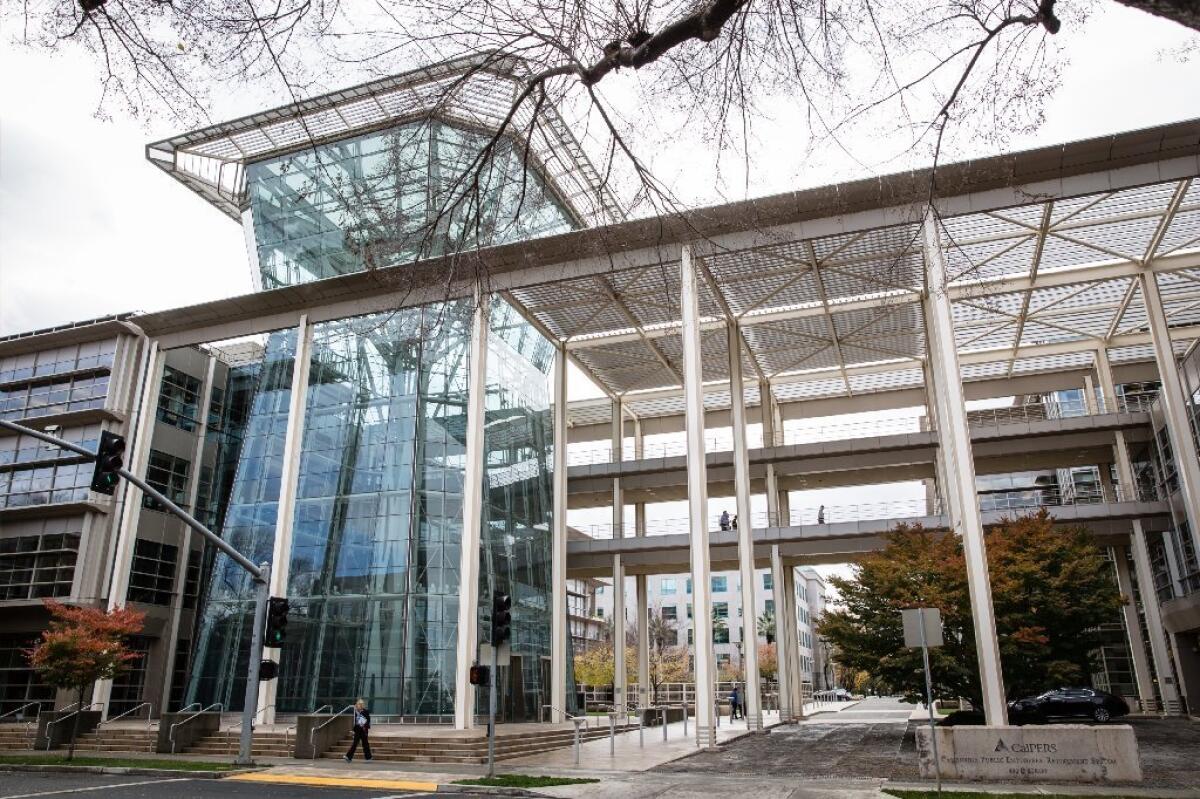Taxpayers may have to ante up more because CalPERS may risk less

CalPERS may lower its expected investment return rate, increasing the amount that taxpayers must contribute. Above is CalPERS’ headquarters in Sacramento.
- Share via
Mostly because of rising pension costs, Long Beach says it faces an estimated $7.5-million budget gap next year. Officials already are outlining cuts across the city, including million-dollar reductions in the police and fire departments.
Now a plan considered Tuesday by the California Public Employees’ Retirement System could raise those pension costs even higher, continuing to erode government services in Long Beach and in cities across the state.
Under the proposal, CalPERS would gradually move more of its $300-billion portfolio to safer investments that earn lower returns. As a result, investment income would provide less money for public pensions, and taxpayers would be expected to kick in substantially more.
A final vote on the plan could happen as soon as next month.
CalPERS staff members say the changes are necessary to improve the financial stability of the fund, which provides benefits to 1.7 million employees and retirees of the state government, cities and other local agencies.
They say that moving more money into safer investments like bonds will reduce the chance of a loss similar to the 28% plunge the fund suffered in 2008 during the financial crisis.
CalPERS already needs $100 billion to cover what it owes to employees and retirees. And a steep decline in the markets would dig that hole far deeper.
“We have a significant risk that we need to address more aggressively,” said Bill Slaton, who represents Gov. Jerry Brown on the CalPERS board, at Tuesday’s meeting in Sacramento.
Slaton proposed making the changes even faster than the plan laid out by the pension fund’s staff.
CalPERS’ proposal is controversial because it requires the fund to reduce its expected annual rate of investment return — an estimate at the heart of determining just how expensive government pensions are for taxpayers.
Government watchdogs have been warning for years that public pension plans across the country are overestimating how much they can earn on their investments.
Currently, CalPERS expects to earn 7.5% annually. This year, after several years of double-digit returns, the fund earned just 2.4%.
The new proposal is the result of CalPERS’ recognition that — even with significantly more contributions from taxpayers — an aggressive investment strategy can’t sustain the level of pensions promised to public workers.
Even now cities are struggling to find money to pay fast-rising pension bills. Cities are in the midst of six-year span in which required payments to CalPERS will rise 50%, according to the League of California Cities.
A recent report by Moody’s, the credit rating firm, found that cities are now paying CalPERS annual amounts that are equal to 32% of salaries paid to police and fire employees. That rate is expected to increase to 40% of salaries in five years, Moody’s said.
The city of Sacramento was already expecting a
$20-million hike in pension costs over the next five years from the $60 million paid this year.
“This is a tough one for us,” Leyne Milstein, Sacramento’s finance director, said of CalPERS’ proposal. “We will be challenged.”
In Long Beach, the city projects its pension rate to rise from 24% of salaries
for public safety workers to 39% over the next five years, said John Gross, the city’s financial management director.
The rate for other employees is lower, he said, but also rising quickly.
CalPERS’ plan will spike those rates even higher, Gross said. Yet the city still approves of the plan, he said, because of its potential to reduce future financial risks.
“Long Beach has supported making pension funding sound and getting rid of unfunded liabilities,” he said. “This is likely to be another step in that direction.”
CalPERS staff members have designed the plan to minimize the effect on cities by slowly making the changes over decades.
The expected annual rate of investment return would be lowered in tiny increments ranging from 0.05% to 0.25% each year — and only in years in which the fund’s investments perform far above expectations.
Historically CalPERS has given the cities a break in those good economic years, by lowering previously announced pension payments.
CalPERS officials estimate that it may take 30 years to reduce the expected rate of return from 7.5% to 6.5%.
In recent years, CalPERS staff has repeatedly warned about the fund’s precarious finances. Contributions from taxpayers and non-retired workers are no longer enough to cover monthly checks sent to retirees.
Last year, governments paid CalPERS $8.8 billion, while employees chipped in an additional $3.8 billion, according to the fund’s financial statements. Those combined amounts fell $5.2 billion short of the $17.8 billion paid to retirees.
The pension fund must pull money from its investments to cover what it calls “negative cash flows.”
Those shortfalls come, in part, from the aging of the government workforce. With increasing retirements of baby boomers, CalPERS estimates that the number of government retirees will exceed the number of working public employees in less than 10 years.
The problem is also the result of a lucrative increase in pension benefits that state legislators voted to give public workers in 1999 when the stock market was booming. The law allowed government workers to retire earlier and earn higher pensions more quickly.
At that time, CalPERS had lobbied for the more generous pension benefits, with the fund’s president
arguing that the increase would help workers “without it costing a dime of additional taxpayer money.”
[email protected]
Twitter: @melodypetersen
More to Read
Inside the business of entertainment
The Wide Shot brings you news, analysis and insights on everything from streaming wars to production — and what it all means for the future.
You may occasionally receive promotional content from the Los Angeles Times.









